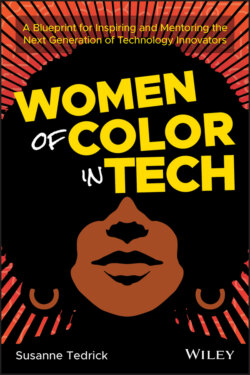Читать книгу Women of Color in Tech - Susanne Tedrick - Страница 10
Primary, Middle, and High School
ОглавлениеAs girls of color begin school, the number who sustain an interest in STEM may continue to drop. On top of low parental involvement and support, girls in general may not be actively encouraged by their friends, teachers, or school faculty to take STEM classes or participate in STEM after-school activities.
This assumes that STEM classes and activities are even offered in their school or local community. Although as a society it seems we've placed a premium on STEM education, there are still many places in the United States that are “STEM deserts” or a lack of schools that offer STEM education that prepares students for college-level work and careers. According to Education Week, STEM deserts are likelier to exist in high-poverty schools (schools where 75 percent or more of the students are eligible for free lunch and breakfast). Almost half of these schools have large Black and Hispanic populations.
This lack of encouragement and access can lead girls to form and hold limiting, confidence-destroying beliefs that these subjects are too hard for them or not meant for them.
For the girls who do stay in STEM classes, they may be picked on or bullied by their male peers—and their teachers. Teachers' own gender and/or racial biases may creep in during classroom lessons, causing them to call on girls less to answer questions in class or even belittle them in front of other students. Bullying or mean behavior from both teachers and peers can compound any doubts and fears girls may have about their abilities.
In my seventh-grade algebra class, I remember getting back an exam from the teacher, where I received 98 out of 100 points. Written next to the score was not a “Great job” or something similar—it was the word “Careless” in very big red letters.
After class, I asked what I had been “careless” about. The teacher commented that I had forgotten to add a negative sign in my answer to one of the equations, in which he took away two points from my overall grade. He continued to say that I needed to not make such careless mistakes if I want to be “any good at math” and that I should review my work more closely.
I was surprised and crushed. I thought 98 was a pretty good score, especially since algebra (and mathematics in general) was a subject where I needed more help and study time with than other subjects. I was proud of myself, as I really worked hard to do well on that exam, and yet when I left the classroom, I didn't feel good at all.
At home, parents or guardians who don't quite grasp the subject matter, or find the value in it, may not offer meaningful or constructive help when needed. Many parents have reported that they have difficulty helping their children with homework, especially in math and science subjects. Although some may have the means to hire tutors or put their children in remedial courses, many may not. For households that are economically disadvantaged, tutoring is a luxury they cannot afford.
Parents may not be aware of free educational resources that can help their children, or they may not know where or how to locate these resources. For one-parent households, parents juggling multiple jobs, or parents supporting other aging or ill family members (often situations present in households of color), there may be a lack of both money and time. Students may try to find or put together solutions on their own to get the help they need or, because they have lack of guidance, may not get any help at all.
